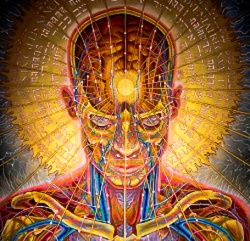Difference between revisions of "Emptiness,"
| Line 13: | Line 13: | ||
Teachings on [[emptiness]], [[shunyata]], come to the forefront in [[Mahayana]] in the [[Prajnaparamita]] {{Wiki|literature}}. In the [[Tibetan tradition]], the teachings of [[Prajnaparamita]] are associated with [[Nagarjuna]] and the [[Madyamika]] School, although historically these were three {{Wiki|independent}} [[phenomena]]. | Teachings on [[emptiness]], [[shunyata]], come to the forefront in [[Mahayana]] in the [[Prajnaparamita]] {{Wiki|literature}}. In the [[Tibetan tradition]], the teachings of [[Prajnaparamita]] are associated with [[Nagarjuna]] and the [[Madyamika]] School, although historically these were three {{Wiki|independent}} [[phenomena]]. | ||
| − | In the [[Madyamika]] [[view]], there are [[two truths]]. The [[absolute truth]] of [[no-thing-ness]], and the [[relative truth]] of [[phenomena]]. [[No-thing-ness]] and [[phenomena]] are always co-present, [[inseparable]]. [[Phenomena]] arise as an array of [[sense]] [[perceptions]], [[feelings]], and [[thoughts]] erupting continually in [[consciousness]]. [[Phenomena]] are the {{Wiki|sensual}} dance of [[consciousness]]. If you try to [[grasp]] at the dance it will slip through your fingers because it is just [[dream]] stuff, [[no-thing-ness]]. But you can’t say it doesn’t [[exist]], because it is appearing now. The texts say: | + | In the [[Madyamika]] [[view]], there are [[two truths]]. The [[absolute truth]] of [[no-thing-ness]], and the [[relative truth]] of [[phenomena]]. [[No-thing-ness]] and [[phenomena]] are always co-present, [[inseparable]]. [[Phenomena]] arise as an array of [[sense]] [[perceptions]], [[feelings]], and [[thoughts]] erupting continually in [[consciousness]]. [[Phenomena]] are the {{Wiki|sensual}} [[dance]] of [[consciousness]]. If you try to [[grasp]] at the [[dance]] it will slip through your fingers because it is just [[dream]] stuff, [[no-thing-ness]]. But you can’t say it doesn’t [[exist]], because it is appearing now. The texts say: |
“There might be someone with an intent to know the [[thoughts]] of [[sentient beings]] in the three times for as many [[kalpas]] as [[sentient beings]] [[exist]]; still he would be unable to know the [[nature]] of a single [[thought]] of the [[Buddha]].” | “There might be someone with an intent to know the [[thoughts]] of [[sentient beings]] in the three times for as many [[kalpas]] as [[sentient beings]] [[exist]]; still he would be unable to know the [[nature]] of a single [[thought]] of the [[Buddha]].” | ||
| − | In [[Yogacara]], the [[two truth]] [[view]] was articulated more precisely. The [[Wikipedia:Absolute (philosophy)|ultimate]] remains the [[Wikipedia:Absolute (philosophy)|ultimate]]. The [[relative]] is [[realized]] as having two aspects – the [[actuality]] of [[pure]] [[experience]], the fact [[phenomena]] do occur, that [[appearances]] are {{Wiki|present}}, even though they are always changing – and the [[empty]] [[nature]] of any interpretation or explanation we might attach to that [[appearance]]. | + | In [[Yogacara]], the [[two truth]] [[view]] was articulated more precisely. The [[Wikipedia:Absolute (philosophy)|ultimate]] remains the [[Wikipedia:Absolute (philosophy)|ultimate]]. The [[relative]] is [[realized]] as having two aspects – the [[actuality]] of [[pure]] [[experience]], the fact [[phenomena]] do occur, that [[appearances]] are {{Wiki|present}}, even though they are always changing – and the [[empty]] [[nature]] of any [[interpretation]] or explanation we might attach to that [[appearance]]. |
[[Consciousness]] is always interfused with [[phenomena]]. [[Consciousness]] never changes – [[consciousness]] is always [[consciousness]], but [[phenomena]] are ever changing. Submerged in [[phenomena]] we lose [[consciousness]]. Living at the edge of fresh [[appearance]] we regain it. The texts say: | [[Consciousness]] is always interfused with [[phenomena]]. [[Consciousness]] never changes – [[consciousness]] is always [[consciousness]], but [[phenomena]] are ever changing. Submerged in [[phenomena]] we lose [[consciousness]]. Living at the edge of fresh [[appearance]] we regain it. The texts say: | ||
| − | “Who does not see the [[object]], sees the wonder.” | + | “Who does not see the [[object]], sees the [[wonder]].” |
Although [[form]] and [[emptiness]] are [[inseparable]], practitioners sometimes lean one [[direction]] or the other. Those who lean in the [[direction]] of [[form]] take the [[view]] that the [[Buddhist path]] is one of long, slow incremental steps of reconditioning our [[awareness]] to receive the fullness of [[enlightenment]]. Those who lean in the [[direction]] of [[emptiness]] take the [[view]] that we are inherently [[enlightened]] and only need to stop obstructing its natural presence in our [[lives]]. | Although [[form]] and [[emptiness]] are [[inseparable]], practitioners sometimes lean one [[direction]] or the other. Those who lean in the [[direction]] of [[form]] take the [[view]] that the [[Buddhist path]] is one of long, slow incremental steps of reconditioning our [[awareness]] to receive the fullness of [[enlightenment]]. Those who lean in the [[direction]] of [[emptiness]] take the [[view]] that we are inherently [[enlightened]] and only need to stop obstructing its natural presence in our [[lives]]. | ||
| Line 27: | Line 27: | ||
There is [[form]] because the [[mind]] craves it. When the [[mind]] stops [[craving]] [[form]], [[mind]] relaxes and [[form]] ceases to [[exist]]. [[Form]] is a product of our [[desire]]. [[Seeing]] what animates [[form]] gives all [[form]] a single {{Wiki|taste}}, that of [[bliss]]. [[Bliss]] is the end of all [[desire]]. | There is [[form]] because the [[mind]] craves it. When the [[mind]] stops [[craving]] [[form]], [[mind]] relaxes and [[form]] ceases to [[exist]]. [[Form]] is a product of our [[desire]]. [[Seeing]] what animates [[form]] gives all [[form]] a single {{Wiki|taste}}, that of [[bliss]]. [[Bliss]] is the end of all [[desire]]. | ||
| − | But the end can be nowhere else but at the beginning. The {{Wiki|present}} is the source of all [[thoughts]] and [[desires]]. To attain [[bliss]] is not a {{Wiki|matter}} of shuffling [[desires]] in some better way, but to let them subside, to become desireless. The [[bliss]] of [[desire]] is partial [[bliss]], fleeting [[pleasure]]. The [[bliss]] of desirelessness is complete. | + | But the end can be nowhere else but at the beginning. The {{Wiki|present}} is the source of all [[thoughts]] and [[desires]]. To attain [[bliss]] is not a {{Wiki|matter}} of shuffling [[desires]] in some better way, but to let them subside, to become [[desireless]]. The [[bliss]] of [[desire]] is partial [[bliss]], fleeting [[pleasure]]. The [[bliss]] of desirelessness is complete. |
[[Emptiness]] is the [[view]] of no-view. The school of direct pointing does not have a single [[tenet]]. [[Phenomena]] rise and fall, yet in the [[experienced]] {{Wiki|present}}, nothing rises or falls. It is all already here in the [[infinite]] {{Wiki|continuum}} of space-awareness. The texts say: | [[Emptiness]] is the [[view]] of no-view. The school of direct pointing does not have a single [[tenet]]. [[Phenomena]] rise and fall, yet in the [[experienced]] {{Wiki|present}}, nothing rises or falls. It is all already here in the [[infinite]] {{Wiki|continuum}} of space-awareness. The texts say: | ||
Latest revision as of 18:31, 17 March 2015
The contemplative and philosophical truths of Buddhism arise out of the enlightenment experience of Shakyamuni Buddha. The experience is singular. The possible ways of understanding it are diverse. This is why the dharma is vast. It presents itself in infinite ways according to the needs and desires of sentient beings.
Emptiness is implicit in the Buddha’s earliest teachings. The Buddha denied substance, or ‘thingness’, to reality. Reality is no-thing-ness. There is no higher self or lower self. There is no self at all. What everything has in common is no-thing-ness, not self.
The dharma itself is no thing either. It’s just a glimpse of freedom, the freedom that is possible by avoiding the extremes of nihilism – acting as if nothing matters, and eternalism–acting as if we will live forever.
In the Abhidharma, Buddhist philosophers took an analytical approach to deconstructing appearances into their component, causal conditions. Reality was broken into about one hundred elements. The Yogacara philosophers carried this analysis into the Mahayana, enhancing it within the larger perspective of the Great Vehicle.
These elements form a continuum of potential combinations and arrangements that appearance can take. Knowing the elements means knowing the underlying principles that govern the world as we experience it. Knowing the underlying principles one can apply them in a way that leads to liberation.
Teachings on emptiness, shunyata, come to the forefront in Mahayana in the Prajnaparamita literature. In the Tibetan tradition, the teachings of Prajnaparamita are associated with Nagarjuna and the Madyamika School, although historically these were three independent phenomena.
In the Madyamika view, there are two truths. The absolute truth of no-thing-ness, and the relative truth of phenomena. No-thing-ness and phenomena are always co-present, inseparable. Phenomena arise as an array of sense perceptions, feelings, and thoughts erupting continually in consciousness. Phenomena are the sensual dance of consciousness. If you try to grasp at the dance it will slip through your fingers because it is just dream stuff, no-thing-ness. But you can’t say it doesn’t exist, because it is appearing now. The texts say:
“There might be someone with an intent to know the thoughts of sentient beings in the three times for as many kalpas as sentient beings exist; still he would be unable to know the nature of a single thought of the Buddha.”
In Yogacara, the two truth view was articulated more precisely. The ultimate remains the ultimate. The relative is realized as having two aspects – the actuality of pure experience, the fact phenomena do occur, that appearances are present, even though they are always changing – and the empty nature of any interpretation or explanation we might attach to that appearance.
Consciousness is always interfused with phenomena. Consciousness never changes – consciousness is always consciousness, but phenomena are ever changing. Submerged in phenomena we lose consciousness. Living at the edge of fresh appearance we regain it. The texts say:
“Who does not see the object, sees the wonder.”
Although form and emptiness are inseparable, practitioners sometimes lean one direction or the other. Those who lean in the direction of form take the view that the Buddhist path is one of long, slow incremental steps of reconditioning our awareness to receive the fullness of enlightenment. Those who lean in the direction of emptiness take the view that we are inherently enlightened and only need to stop obstructing its natural presence in our lives.
There is form because the mind craves it. When the mind stops craving form, mind relaxes and form ceases to exist. Form is a product of our desire. Seeing what animates form gives all form a single taste, that of bliss. Bliss is the end of all desire.
But the end can be nowhere else but at the beginning. The present is the source of all thoughts and desires. To attain bliss is not a matter of shuffling desires in some better way, but to let them subside, to become desireless. The bliss of desire is partial bliss, fleeting pleasure. The bliss of desirelessness is complete.
Emptiness is the view of no-view. The school of direct pointing does not have a single tenet. Phenomena rise and fall, yet in the experienced present, nothing rises or falls. It is all already here in the infinite continuum of space-awareness. The texts say:
“The Great Perfection is the Mother who produces all Buddhas. It is the antidote of all activity that involves effort. Whichever path one follows and whatever method one adopts, without realization of the Great Perfection, one cannot attain enlightenment.”
In Dzogchen we do not cultivate an elaborated view. We are not under compulsion to accept or reject anything. Everything is primordially settled. Emptiness is not an object of knowledge. It is not a path. It is not a cure. It is not something that settles or resolves anything. It just is. And you must see it for yourself.


